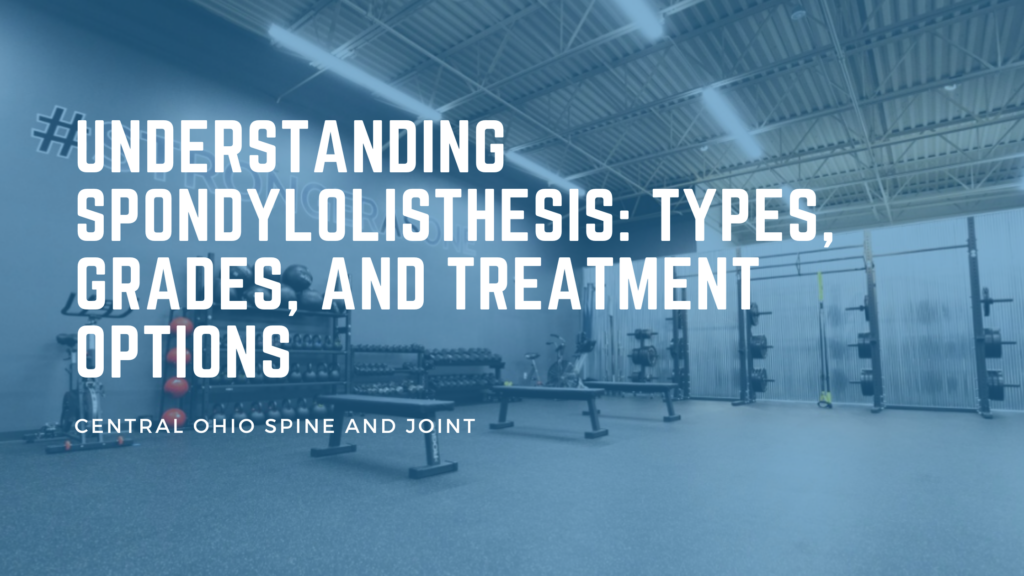Spondylolisthesis is a spinal condition that occurs when one vertebra slips forward over the one beneath it. While it can affect individuals of all ages, it’s particularly common in adolescents involved in sports and in adults due to degenerative changes. This slippage can lead to a range of symptoms, from mild back pain to nerve compression and impaired mobility.
In this post, we’ll explore the causes and symptoms of spondylolisthesis, how it’s diagnosed, the grading system used to determine severity, and both conservative and surgical treatment options.
What is Spondylolisthesis?
Spondylolisthesis (from the Greek “spondylo” meaning spine and “listhesis” meaning slippage) is the anterior displacement of a vertebra in relation to the vertebra below. It most commonly occurs in the lower lumbar spine, particularly at L5-S1, and can lead to instability, nerve impingement, and chronic low back pain.
Types of Spondylolisthesis
Spondylolisthesis is classified into several types based on its underlying cause:
- Isthmic Spondylolisthesis:
Caused by a defect or stress fracture in a part of the vertebra called the pars interarticularis. This type is common in athletes who participate in activities that involve repetitive hyperextension, such as gymnastics or football. - Degenerative Spondylolisthesis:
Seen in older adults due to age-related changes in the facet joints and intervertebral discs, leading to instability and slippage. - Congenital (Dysplastic) Spondylolisthesis:
Occurs due to abnormal development of the spine that predisposes an individual to slippage. - Traumatic Spondylolisthesis:
Resulting from acute trauma causing fracture or instability in the spinal structure. - Pathologic Spondylolisthesis:
Caused by disease processes such as tumors or infections that weaken the structural integrity of the spine. - Post-surgical (Iatrogenic) Spondylolisthesis:
Can occur following spinal surgery, particularly when part of the bone or stabilizing structures have been removed.
Symptoms of Spondylolisthesis
Symptoms vary depending on the degree of slippage and whether nerve compression is present. Common symptoms include:
- Low back pain that may worsen with activity or prolonged standing
- Stiffness in the back and hamstrings
- Pain radiating into the buttocks or legs (sciatica-like symptoms)
- Numbness or tingling in the legs
- Weakness in the lower extremities
- In severe cases, changes in posture or a waddling gait
Children and adolescents may experience symptoms after a growth spurt or an athletic injury, whereas older adults typically develop symptoms due to degenerative changes.
Grading of Spondylolisthesis
The severity of spondylolisthesis is classified by the Meyerding grading system, which measures the percentage of forward slippage of the vertebral body in relation to the one below it:
- Grade I: 0–25% slippage
- Usually mild with minimal symptoms
- Grade II: 26–50% slippage
- May cause intermittent symptoms, often managed conservatively
- Grade III: 51–75% slippage
- More likely to cause nerve compression, instability, and noticeable symptoms
- Grade IV: 76–100% slippage
- Often associated with significant nerve involvement and spinal deformity
- Grade V: >100% slippage (also called spondyloptosis)
- A complete slippage, rare but severe, usually requiring surgical intervention
Imaging (X-rays, CT, or MRI) is used to determine the grade and rule out other spinal pathology.

Diagnosis
Diagnosis involves a thorough physical examination and imaging studies. Key elements include:
- History and Physical Exam: Assess for pain patterns, neurological deficits, and functional limitations.
- X-ray: Lateral views show the degree of vertebral slippage.
- MRI: Assesses for nerve compression, disc integrity, and soft tissue involvement.
- CT scan: Offers detailed visualization of bony structures, useful in identifying pars defects.
Special tests like the stork test (single-leg hyperextension test) can help identify stress reactions in athletes.
Conservative Treatment Options
Most cases of Grade I and II spondylolisthesis can be managed without surgery:
- Activity Modification:
Avoiding activities that aggravate symptoms, particularly hyperextension. - Physical Therapy:
Focused on core stabilization, hamstring stretching, lumbar mobility, and posture correction. - Manual Therapy & Chiropractic Care:
Mobilization of adjacent segments and soft tissue work may help with symptom relief and mobility. - Dry Needling & Shockwave Therapy:
Used to address chronic muscle tightness and pain associated with compensatory patterns. - Bracing:
May help in younger patients with isthmic spondylolisthesis to reduce movement and encourage healing. - NSAIDs and Pain Management:
To reduce inflammation and improve comfort during physical therapy.
When is Surgery Indicated?
Surgical intervention is typically considered for:
- Persistent pain despite 3–6 months of conservative care
- Progressive neurological symptoms (e.g., weakness, loss of bowel or bladder control)
- High-grade slips (Grade III–V)
- Evidence of spinal instability or deformity
Common surgical procedures include:
- Spinal fusion: Stabilizes the affected vertebrae
- Decompression (laminectomy): Relieves pressure on spinal nerves
- Instrumentation (rods/screws): Often used in fusion to improve spinal alignment and support
Post-surgical rehab is essential to restore core strength and movement patterns.
Prognosis and Long-Term Management
The outlook for individuals with spondylolisthesis varies based on age, grade, and treatment approach. Most patients with low-grade slips improve significantly with conservative management. High-grade slips or those with neurological symptoms may require surgery, but outcomes are generally favorable with proper rehabilitation.
Long-term strategies include:
- Maintaining core strength and flexibility
- Avoiding repetitive hyperextension
- Managing weight to reduce spinal load
- Periodic reevaluation and imaging when indicated
Conclusion
Spondylolisthesis can be a frustrating condition, but with early diagnosis and a tailored treatment plan, most individuals can return to a high level of function. Understanding the type and grade of slippage is crucial for determining the best approach to care—whether it’s conservative therapy or surgical management.
If you’re experiencing low back pain or symptoms of nerve irritation in the legs, it’s essential to get a thorough evaluation. At our clinic, we specialize in evidence-based assessment and personalized care plans for spinal conditions like spondylolisthesis.

Recent Comments